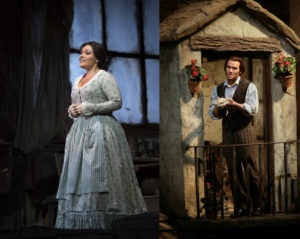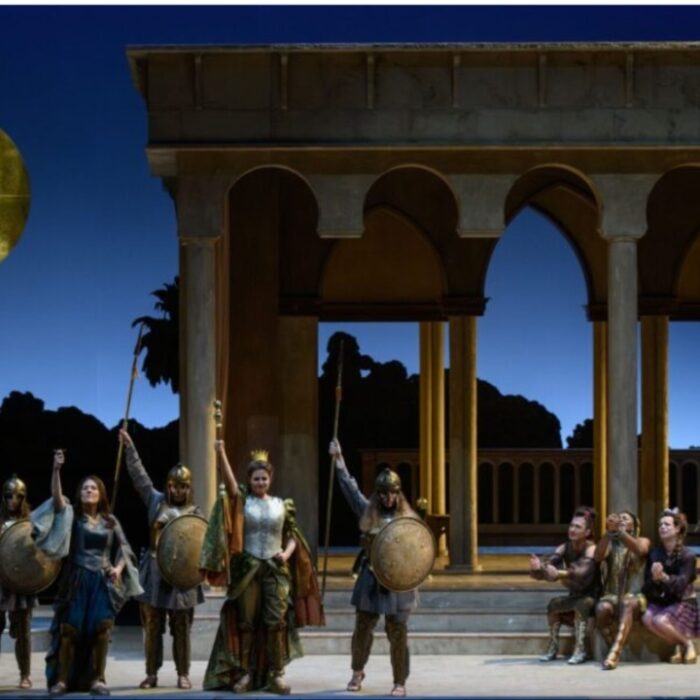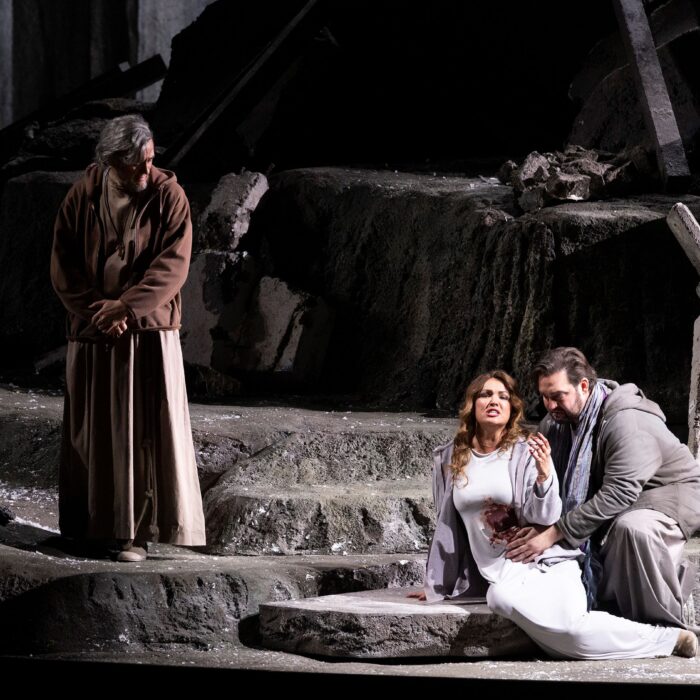
Metropolitan Opera 2016-17 Review – La Bohème: This Is No Routine Production As Fabiano, Pérez & Co. Deliver Vivacity to Powerful Tragedy
By David SalazarThis review is for the performance on Wednesday January 11 and is written jointly by David & Francisco Salazar.
Applause rang from every corner of the Metropolitan Opera, the audience awaiting the final performer to step onstage so that she too could get her accolades. The moment Ailyn Pérez walked out of the iconic golden curtain, she was not only serenaded with applause, but with a flying bouquet of flowers. Every other performer that had come out before her saw a flower flung in his or her direction, the thrower repeatedly missing his or her mark.
And the same seemed likely for Pérez, the bouquet flying away from the direction she steered toward. But in a moment that sent gasps through the audience and then even more cheering, the soprano caught the bouquet with one hand and held it over triumphantly. The night belonged to her and her colleagues, and the gesture, eliciting enthusiastic emotion from the spectators, encapsulated one of the finest “Bohème’s” that the Metropolitan Opera has put on its stage in recent years.
With 1,304 performances through last night, “La Bohème” is indisputably the most popular work in the Met’s repertory. No other opera has gotten as many chances on its stage in all of its history. The last time that Puccini’s venerated classic did not appear in a season was the 2012-13 season; in recent history, 2012 and 2013, 1978, 1979 and 1980 are the only calendar years that have not presented “La Bohème” at the Met.
The popularity of the work needs no explanation, and neither does Franco Zefirelli’s gorgeous production. People still marvel when the Act 2 curtain rises on the Paris square, as alive with energy as the streets outside the Metropolitan Opera. Act 3 is without a doubt the most poignant of all, the falling snow and icy atmosphere beautifully contrasted with the most riveting and emotional passages of an opera laden with them.
The big issue with presenting an opera so much is that it can border on routine. Most of the jokes remain the same and in the wrong hands can come off as labored and uneventful. Throw in the fact that despite its glorious romance, Puccini’s work is far from the dynamic dramatic firecracker that “Tosca” or “Turandot” are. It’s charm thus relies heavily on chemistry not only between the evening’s Rodolfo and Mimì, but the entire ensemble.
That task can be harder to attain than one might expect with few recent productions able to provide brilliance in every role.
But the cast assembled for this final run in 2016-17 season fulfills said promise.
A Leading Man That Needs More Met Engagements
For many the big attraction was tenor Michael Fabiano, returning to the Met after a few years. Last time he was here, he took on this very role to great plaudits. Since then, the tenor has grown as an artist and on account of his work on Wednesday, he promises to be one of the most thrilling at the Met for years to come.
Fabiano is a passionate artist, he holds back nothing when the music asks for it. Puccini’s music in this work ebbs and flows, the climaxes reaching unbearably rich extremes and the valleys offering moments for subtlety and grace. You can feel the climaxes coming and the suspense of seeing a singer match the emotional heights creates tremendous tension for the spectator. Fabiano crowns those climaxes with an incredible production of sound that gleans with clarity and ease. This was most evident during the famed climax of the aria “Che gelida manina” and the opening lines of the love duet with Pérez. In all he played Rodolfo with his heart on his sleeve, the bohemian writer as impulsive as he was playful.
During his initial flirtation with Mimì, he grazed her hands gently, but not quite subtly, letting her know without any pretension that he was into her. This allowed for a rather physical relationship to grow between them, the sense of a youthful rashness setting into the relationship. Smiles and tender cuddling were apparent throughout the duet, which was counterpointed rather nicely when Rodolfo shows off his jealous side at the start of second act. Seeing Mimì hug some random stranger in the street, he pulled her away rather forcefully, his contempt rather apparent. But in just moments, he softened again as the two smiled right into each others’ eyes.
The third act saw him showcase more of that violent edge as he was pushed about by Marcelo, a subtle lunge forward that he promptly stopped, suggesting this Rodolfo is not one to take things easy. He moved away, his voice melting with the mournful “Mimì è tanto malata.” He was wonderful vocally throughout the entire evening, but the two contrasting passages “Mimì è una civetta” and “Mimì è tanto malate” showcased his great vocal artistry. During the first passage, in which he shifts all of the romance’s shortcomings on his lover, Fabiano’s voice retained a forward brightness, every phrase given a pointed direction and his volume rather ample and powerful. It was tossed off with such ease and directness that it had an aloofness to it. Other tenors will indulge a bit, making Rodolfo seem like a whiner, but this approach made him a bit colder.
This allowed the second passage and the heartwrenching “Una terribile tosse,” where Rodolfo finally admits to his true sorrow, to be profoundly moving. In an evening where faster tempi were favored and rubati were used sparingly, Fabiano stretched the pacing a bit here, his voice dipping to a quieter volume and pulling the audience in. His voice thus had more distance to travel (imagine a car going from 10 to 100 in a matter of second) to bloom into the Puccini’s passionate outbursts, the effect all the more wrenching for the listener.
The final act, while belonging to Pérez (more later), saw some poignant moments from Fabiano, his duet with baritone Alessio Ardiuni, rather intimate in its approach, their voices taking on a lighter complexion, the climaxes more subdued, the forlorn men coming off as disappointed and directionless rather than sulking in misery. Throughout the final death scene, Fabiano wore a smile, giving a sense of hope and positivity amidst the tragedy. Seeing him go from a grin as he recited “Vedi, è tranquila” to the shock of realizing his beloved Mimì was dead was all the more impactful. He rushed to the bed and lifted her up, almost as if to shake her back to life, the impulsive nature of the character taking over. But then as he held her in his arms, he put her down, his mournful “Mimì” sung with ringing through the space with tremendous vibrance and force. The second one was an even more breathtaking as Fabiano, instead of cutting it off, used portamento to transition the note into a heated cry, his face burying itself into the corpse of his beloved, the final chords of the opera thundering.
It must also be emphasized that his chemistry with Pérez was wonderful in how unpredictable it was. The two relished the fact that they were playing young inexperienced everyday people. They flirted as such, their advances becoming more and more playful, the sexual tension building. When Mimì hints that she does not want to say what she would like to do at the end of the act, the subtext was pretty apparent from the way their bodies caressed one another. It was a nice contrast to the more mature and delicate tenderness with which they held each other in the third act to launch the gorgeous “Dunque è proprio finita.” Great chamber music and singing requires that the artists working together match one another not only phrase for phrase and dynamic for dynamic, but in vocal quality and vibrato. Despite limited rehearsal time, the two were very much intune with what the other was doing from the get-go, their voices matching every line they sang together, giving a true sense of unified lovers.
The final act saw a combination of tender flirtation, the physicality between the two remaining a major point of connection. Fabiano was quite potent dramatically during the section where Mimì starts to sing his lines form “Que gelida manina,” his face filled with intense sorrow, the call back taking on an even more tragic dimension instead of being a hopeful reminiscence.
Ailyn Pérez’s Best Work At the Met To Date
Ailyn Pérez sang the first run of Puccini’s opera in the fall and she received great acclaim for her work in the role. On Wednesday it was apparent why she is one of the most in demand Mimì’s. Her interpretation pits the heroine that is already ill from the beginning but her character’s beaming energy quickly makes the audience forget the impending death of this character. When Pérez’s Mimì meets Fabiano’s Rodlofo there is already a flirtatious quality to this character that is carried out in the second act. As Fabiano is singing his ardent “Che Gelida Manina,” this Mimì is throwing smiles at him.
During her “Si Mi Chiamano Mimì” Pérez took a rather swift tempo not holding onto the lines as most would do. But this was a characteristic of her character’s undying energy. But she effectively imbued the aria with a strong nostalgia and hopefulness during the aria’s climatic moment “Ma quando vien io sgelo.” Here Pèrez pulled the tempo back a bit, her voice lighter but growing with passion as she described her love for the spring, the vibrato growing faster. A smile put the cherry on top, giving the passage a sense of loss and yet tremendous joy. And as she ended the aria simply telling her Rodolfo that she was disturbing him, her flirtatious quality returned with pointed articulation on the words, the shy girlishness on full display.
In act two in the Paris Scene, there were no signs of illness as Pérez participated in nearly every inch of the crowded scenes. She interacted with the clowns, with a number of town people and relished each moment as she picked out the pink bonnet. And then during the final choral scene she was a huge contrast to her Musetta. While Susanna Phillips’ voice was bright and brilliant prickly, Pèrez’s voice had a creamier feel similar to the characteristics of her Mimi who was relishing each moment with Rodolfo.
In Act three the bright energy that beamed from the first two acts was gone, the growing weakness taking prominence in its stead. In her duet with Marcello as she pleads for help, Pérez’s Mimì was sickly, but the intensity in the voice actually ratcheted up a few notches, as if clinging or searching for the long losted exuberance. The forte carried great weight in its quality which was a great contrast to her singing in the first two acts. But one of the most unforgettable moments of the night came at the end of “Donde Lieta Uscì.” As Pérez sang the line “Senza Rancor” she held the notes out as if trying to hold on and not let go of Rodolfo. The pianissimo lines floated through the Met and she ended in a beautiful whisper all while holding on to Fabiano’s hand. It might have been the most touching moment between the two lovers, the tragedy’s full weight felt in the most delicate and subtle of gestures.
Pérez’s performance of Mimì’s death carried tremendous realism in how the voice expressed the character’s predicament. In a paradoxical move, the soprano retained complete control over her vocal resources while making it sound like she was struggling to do just that. Her voice was minimized to a growing whisper, the vibrato almost completely absent and the lines tapered off at the end, each time growing shorter and shorter. But it never had “breathiness” or sounded labored, much less exaggerated. It added tension and great contrast to the full-bodied voice that Fabiano employed in their final duet. The result was a heart-wrenching account that is by far Pèrez’s greatest role at the Metropolitan Opera thus far.
Susanna Phillips Continues To Dominate As Musetta
Susanna Phillips has dominated the role of Musetta for quite some time. She has sung the role 43 times at the house including her Met debut and to this date she finds new ways to maintain it fresh. Her voice has a bright color and flexibility that allows her to easily get into the role. The moment she rides into the stage, she exudes a wild energy, running around the stage, throwing plates and demanding better shoes. But the moment Phillips sings her lush waltz “Quando me’n vo,” Phillips pours her lush voice all while smiling and flirting with Marcello and Schaunard.
The jovial spirit is equally shown at the end of act three in the quartet. While Mimì and Rodolfo are singing about breaking up with such tenderness, Phillips’ Musetta has no qualms with flirting and upsetting Marcello. Whereas the two main lovers sing with lush and polished legato lines, her voice attacks every note with relish. It all seems like a game to
But the coquette Musetta becomes more reserved in Act four. It is easy to overlook her prayer at the end of act four. However, Phillips’ rendition, sung with a more velvety tone gives Musetta a vulnerability that often gets overlooked.
A Colorful Group of Bohemians
The remaining male singers rounded out the opera quite effectively. Arduini has not any other opera as of yet with the company, but this is his first Marcelo. In the past he sang a rather spirited Schaunard, but here he brings maturity and reserve to his Marcelo. Whereas Fabiano’s Rodolfo had an edgier quality, Arduini’s Marcello countered with a more assured presence. This was reflected in his singing, more calculated and polished in its phrasing, every word given tremendously clear diction. You often got the sense that Marcello was the leader of the quartet of Bohemians from those earlier interactions.
This reserved nature highlighted the more “immature” moments that Marcello has when Musetta arrives on the scene. Without her he is serene and collected. With her, he is an emotional wreck, his singing far more agitated and pointed, his behavior more erratic. This was clearest in Act 3 in two contrasting moments. He pushed Rodolfo around when he called him out on his behavior toward Mimì, but a playfulness remained. But when it came to fighting back at Musetta, he looked ready to take down one of the other men flirting with her.
As Schunard, Alexey Lavrov was the goof of the group, throwing himself into the ballet and tap dancing with such gusto that the already excited Met audience exploded with prolonged laughter. Christian Van Horn gave an elegant account of Colline, his character playing up the fun and laughter but also giving an introspective account of the famous “Vecchia zimarra,” his voice delicate, his phrasing smooth and drooping to emphasize the sadness of the moment.
As has become tradition, Paul Plishka played both Alcindoro and Benoit and as has become expected of his delightful interpretations, he had no issues with playing up the two characters’ extreme natures.
In the pit Carlo Rizzi drove a refreshing account of Puccini’s score. Whereas most conductors love to play up the sentimentality of the score by means of excessive rubati and slower tempi, Rizzi actually pushed the pace throughout the drama, withholding rubati for select dramatic moments. In doing so, the rubati actually had more of an impact without detracting from character interactions. It also gave the opera as a whole more vivacity, emphasizing its heavy contrast between a mournful tragedy and scenes of adolescent joviality.
There is only one more performance of this cast in “La Bohème.” Go see it because it might be some time before the Met is able to assemble such a dynamic collection of artists to create such a compelling whole.


